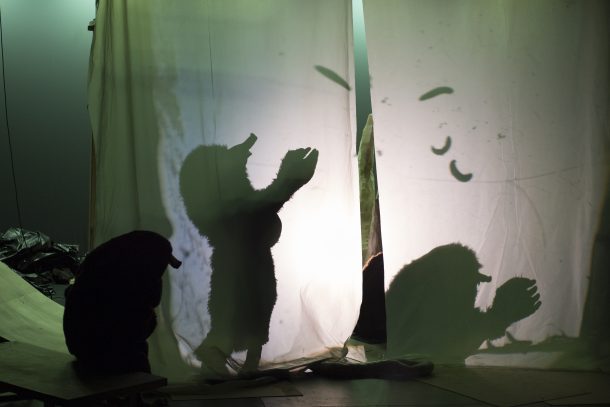The Kunstenfestivaldesarts, directed by Christophe Slagmuylder, is one of the most interesting festivals of theatre innovation in Europe. Among the thirty-five artistic projects presented this year, twenty-five were world premières. The Brussels-based festival presents many Belgian productions, justifying its local roots, but also many productions from other parts of the world, showing a great sensitivity to the diversity of the cultures represented, to bring, in each case, innovative productions within their context. Therefore, the festival presented a wide variety of productions from places such as Holland, Sweden, France, Spain, Italy, Morocco, Egypt, the Congo, Mozambique, Syria, Iran, Japan, Thailand, Korea and the USA. The Festival lasted three weeks from 6–28 May 2016, and was highly successful with attendance at ninety-five percent.
As one of two directors occupying a prominent place in the festival, Philippe Quesne presented a large project in two parts. The first, La nuit des taupes (The Night of the Moles), introduces us to a poetic underground world: the world of the moles and their caves. The second part, Welcome to Caveland!, presents a set design like an installation, built in the chapel of the Brigittines, that welcomes other artists to develop their own work around the idea of caves in this open space. In a world that makes us into recipients of so much information but is also dominated by inequalities, the cave symbolizes the dream of a space in which we can stop and look within ourselves for that which “confronts the man with himself and with others” (according to the festival press release). The cave becomes a pretext for creative thinking—a laboratory for artists, who, in a ludic way, present unusual performances, workshops, readings and other activities. It is also an attempt at a new form of production and way of sharing artistic projects.
Grouped under the title Caveland! Reflection Day, a series of three Saturday events enabled afternoons of disparate activities in relation to the caves. For example, activities on 21 May (Caveland! Reflection Day: Stratification: Traces of Excess) included a conversation, a lecture and a “performative presentation” by a university group. Another kind of intervention was A Day in Caveland! Artistic Interventions, in which an artist had the space for a full day to prepare and to present a performance in the evening. For example, on 26 May, Begüm Erciyas and Matthias Meppelink presented their work for groups of three people each every twenty minutes. These small audience groups were first guided into the chapel, where they could see three people sitting with earphones in front of computers. Inside of the “cave,” there was a big set piece like a half dome of black plastic where the artists had built three giant mushroom-like structures. Each member of the audience had to go under one of them. Inside was a set of earphones, a microphone, and a book. The audience member had to read the book aloud, in front of the microphone.
Quesne’s La nuit des taupes was one of the first productions of the festival. Presented at the Kaaitheater arts center in Brussels, it depicts an imaginary world in which all of the characters are moles. Seven actors (Yvan Clédat, Jean-Charles Dumay, Léo Gobin, Erwan Ha Kyoon Larcher, Sébastien Jacobs, Thomas Suire, and Gaëtan Vourc’h) disguised as giant moles, with all body parts proportionate to real moles, are the only characters. They do not speak; they do not have names. The audience never sees the face of any actor; they are differentiated only by their size and the color of their fur, each a slightly different shade.
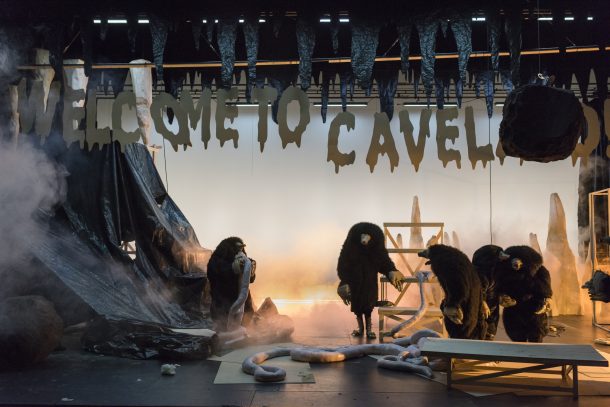
La nuit des taupes (Welcome to Caveland!). Photo: Martin Argyroglo.
At the beginning, the scenery consists of a black backdrop; a promontory at the left side, also covered by black plastic; and a few musical instruments to the right. In the middle of the stage is a cabin with thin gray walls. Over the stage are the words: “Welcome to Caveland.” Suddenly the audience hears somebody kicking the wall of the cabin, making a small hole in the wall. A monstrous fingernail appears in the hole, followed by a big claw—two claws—four claws making the hole bigger. Pieces of the wall are broken away, and suddenly the audience can see, through the wall, the entire profiles of the moles, each the size of a man. Once a big hole is made, all the moles come onto the stage, pushing in front of them balls of rock or earth. Some begin to play musical instruments while others continue to demolish the cabin, until only a metallic framework is left. The moles are presented as gregarious animals that like to work and play together. Soon after they take the stage, one of the moles collapses on the floor. The other moles gather around him, and one of them even gives him mouth-to-mouth, but unfortunately the mole passes away. However, immediately after this they all begin to work again, and a wire is lowered from the ceiling. The dead mole is attached to it, the cable rises, and the mole remains suspended in the air throughout the rest of the performance—probably a parodic Caveland version of the Christian Heaven.
When only the metallic structure of the cabin remains, the second part of the production begins, at a slower pace. Some of the moles play like children, then all begin to eat, followed by an interval of sex and of collective sleep. A screen descends and the moles appear like shadows in a puppet theatre, perhaps reminding us of Plato’s myth of the cave. What they represent in their mole-dreams is difficult to determine, leaving the audience free to interpret. After this show, they seem to participate in a party, dancing around the musicians until the performance ends.
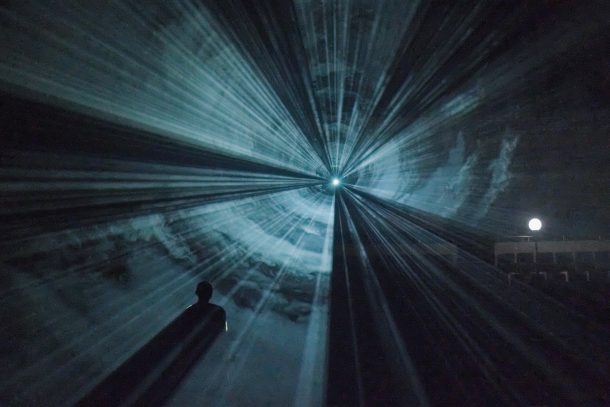
Apichatpong Weerasethakul’s Fever Room. Courtesy of Kick the Machine Films.
The work of the second major directorial presence, Thai filmmaker Apichatpong Weerasethakul, was the subject of a focus program in the festival, consisting of a retrospective of his films, an underground exhibition of his work, and finally, The Fever Room, which with its mixture of film and theatre represents Weerasethakul’s first stage production. The latter, presented in the Brussels City Theatre, was as beautiful, strange and polysemic as his films, presenting some of the most striking visual illusions that I have ever seen in this Festival, indeed in the theatre as a whole. Inside of a huge black box in the middle of the stage, the audience is first introduced to semidarkness. The cave, even if it is never mentioned, is suggested. A film showing scenes in Thailand is projected onto one of the walls of the black box. Sometimes the images bear subtitles indicating places: for instance, “the River Mekong.” A second film is projected simultaneously above the first one, on the same wall. Their images are complementary: they often show the same place from a different point of view. Two more films are then projected on both side walls of the black box; the public is surrounded by four different, often complementary, films.
Suddenly, the wall on which we are watching the projections rises, revealing the entire theatre, the orchestra and the boxes. The audience then realizes that they are actually on stage, in the very place where their gaze would be directed in a conventional production. At this moment the most striking part, from a visual point of view, begins. A light that could be a light bulb is seen at the rear of the orchestra seats, at the height of the boxes. Then this light becomes a beam that explores the stage and the audience, as if it were trying to find something, like the beam of the lighthouse exploring the sea. The audience has the sensation that they are the subject of a search. As a member of the audience I could see the others only when they were illuminated.
Smoke is introduced into the theatre, on stage and also over the orchestra. Then the beam of light acquires the form of a ring, with the help of the smoke. It becomes a moving circle with the audience in the middle, as if at the center of a tornado. The circle fades away and another beam of light draws a sharp triangle over the parterre. As there is still smoke, the area seems like a piece of clouded sky, accented with some nuance of red like a setting sun. Then slowly this beam lowers and the audience has the impression that it is closer to the clouds, or that the sky and the clouds are descending, like the view one can have from an airplane, but in much higher definition. There is a split second when the light reaches the eye-level of each viewer, and then suddenly the viewer is above the clouds, and can see the clouds beneath them. Then this thin and powerful beam of light rises up again. This same amazing phenomenon is repeated a few more times, as if at some point we are able to be above the clouds, to have a dominant overview with clarity, and at other times we can see an important part of the sky but remain beneath the clouds. Once this visual effect disappears, a series of small lights in movement seems to be suspended in the theatre over the parterre. They flicker and fall while the audience hears heavy rain. There is neither text, nor characters, nor action, nor a clear referential meaning. Nevertheless the film images at the beginning and the succession of lights create a continuity in the theatrical space.
A few other outstanding productions challenged the usual limits and categories of the theatre with their creativity and originality. Decoratelier’s INFINI 1-15 was one of the most surprising and beautiful productions of the Festival. The scenographer and director Jozef Wouters developed this project in the scene shop of the City Theatre. His idea was quite original: to build up a production consisting of only a succession of diverse sets, without actors on stage, without a story, and initially without texts. To realize this project, he invited fourteen artists, mostly scenographers, from diverse origins and backgrounds: Anna Rispoli, Arkadi Zaides, Begüm Erciyas, Benny Claessens, Chris Keulemans, Jisun Kim, Michiel Soete, Michiel Vandevelde, Rebekka de Wit, Rimah Jabr, Rodrigo Sobarzo, Sis Matthé, Thomas Bellinck, Wim Cuyvers. A dramaturg, Jeroen Peeters, worked with Wouters from the beginning of the production. Each of the scenographers created a space (called an Infini) and the succession of the diverse spaces gave birth to the entire production. Wouters discussed and worked with most of them in the creation of the spaces. Although in the end, all the scenographers used a written story, the successive sets played the primary role. The huge stage house of the City Theatre allowed the use of a large number of sets at the same time.
As the director himself explained to the public at the beginning of the production, he was inspired by Giovanni Niccolò Servandoni’s work, who after 1738, in Paris, did a few machine plays (spectacles de machines), only with sets, parts of which were animated, setting to the side the actors and dancers that used to be the protagonists of the theatre. Wouters saw the sets as “bridges to the imagination,” and their fragility allowed one to think about space and buildings better than the architecture itself. The production provided an experience completely different from a production with plot, with traditional dramatic action, an aesthetic experience that I haven’t encountered before.
All of the sets were extremely elaborate. Each was displayed for between five and twenty minutes; the overall production, with an intermission, lasted for four hours. In the transitions between the sets, the technicians were visible to the public. The spaces were very different. Most of them were physical spaces; however, in every case the space also had an imagined component. For example, at the beginning of first set, by Michiel Soete, an offstage voice, presumably the artist, says that in his quest to create his Infini landscape he discovered that everything is about light and colors and that all happens in the mind of the viewer. He expresses hopes that the audience would see something different than he did. This Infini was created by lights moving on a screen. Accompanied by music, the lights changed and transformed for about nine minutes. In the second Infini, by Sis Matthé, a painted curtain and several painted elements at different levels showed an imaginary harbor full of containers. A changing array of lighting played across these painted curtains, which did not move. The audience hears a man recounting, in Flemish, the story of the former sets of the Théâtre Royal de la Monnaie in Brussels being stored in containers in the harbor of Antwerp. The third Infini, by Ana Rispoli, combined elements of the previous Infini as a backdrop for a recorded conversation between a man who is in Tunisia and wants to emigrate, and an immigrant woman in Belgium.
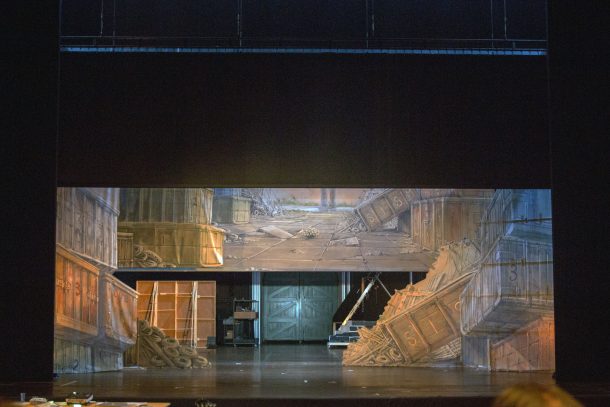
Decoratelier’s INFINI 1-15 (Second Infini, by Sis Matthé). Photo: Phile Deprez.
Each Infini represented an imaginative vista and evoked a different image. Wim Cuyvers, working with Jozef Wouters, proposed the eighth Infini during which Wouters explained that the creators felt that space could not in fact be represented on stage, and thus their Infini was composed of language—six texts about his experience in front of six different places that had touched him at different moments in his life, including a cave in the Ardennes in 1977 and the Church of the Sagrada Familía in Barcelona in 1983. The texts were presented in six huge rolls, which were unfolded slowly, covering all the entire stage opening, each text narrating the movement and the feelings of the author in front of these places.
Many of the sets were moving, and were oftentimes witty and ironic. For example, Rebekka de Wit, who created the tenth Infini, recounted an episode she experienced that aroused a unique feeling for a place. While she was trying to imagine an Infini for this production, she went to the church in Charleston, South Carolina that had been the site of a fatal shooting of nine black parishioners by a white gunman, who had been publicly forgiven at his trial by the victims’ relatives. In this church, originally constructed by black slaves, de Wit had an intense experience, both of sharing of the collective pain and of struggling to maintain a rational reflection on the events. She was struck by a detail: a woman had made a big cake in the form of the church, surrounded by Christmas trees with doves, to express how the killing had transformed her life. Her Infini presented two very small identical models of the church: one intended to represent the church, and another the cake.
For the eleventh Infini, by Thomas Bellinck, a dialogue between a Polish woman and man about how our communications and, indeed, our entire lives are very much controlled was projected in red letters onto a black screen. At the end the two take an elevator together to another level where they encounter a surprising new space, containing a much larger scale model of Rebekka de Witt’s church. Thus her Infini is finally completed, acquiring more importance through the interruption of another Infini.
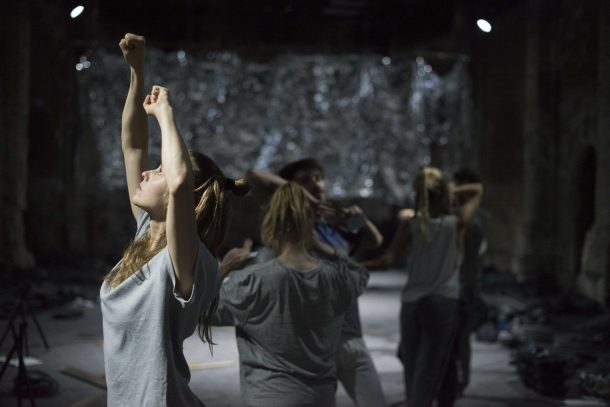
Mårten Spångberg’s Natten. Photo: Anne van Aerschot.
Among the various dance productions, the production by Mårten Spångberg, Natten, was one of the most surprising and highly acclaimed, presented for two nights in Les Brigittines, a performance space made from a former chapel of the order of the Brigittines. Two long curtains with shiny paper were suspended at both sides of the nave, helping create a diffused light. In the middle of the stage, five ropes from which many black plastic bags hung gave the space a dreamlike atmosphere. A few projections of gray light fell in the superior part of the chapel and in the choir; yellow light was projected on the upper part of the side walls. The floor of this empty space was covered by a fitted carpet, and there were cushions and blankets for the audience, close to the walls. On the floor, the audience could find a little book that presented some of the ideas of the production. The dancers sat on the floor, near the rectangular space in the middle that would be the stage. The audience took their places, close to the dancers and on the same level. The dancers (Tamara Alegre, Simon Asencio, Linda Blomqvist, Louise Dahl, Emma Daniel, Hana Lee Erdman, Adriano Wilfert Jensen, Mårten Spångberg, Else Tunemyr, Marika Troili, Alexandra Tveit) danced for seven and a half hours. They wore trousers and casual t-shirts in simple and neutral colors, grays and dark tones; three of them, at some point, wore military trousers.
The dance included two twenty-minute pauses in which the room was darkened, but in fact lasted seven hours—an entire night. Thus, duration was its main topic. The lighting was shadowy, a half-light which slowly changed in intensity. The audience could always distinguish the actors, but very often not their faces. For Spångberg, the night was a moment where identities blurred and the usual distinctions disappeared. There was not the same sense of hierarchy, and sometimes no hierarchy at all. The night provided a way to escape from the treatment of identity by performances, producing a non-distinction between the dancers, but also between every element. Instead of subjectivity, the director sought to stress equality between everything on stage, and their nature as real beings and as objects.
Sometimes a surprising movement provoked vivid attention, but most of the time the feeling was of a floating, relaxed attention, towards the movements and the positions of the dancers, with their immobilities renewed, which created a surprising and rare experience. From the beginning the production created a rupture in the everyday rhythm of life. The program was divided into very precise sequences. Divisions were created by a dancer in a blue cap and a coat reminiscent of the chief of a railway station. He rang two bells to mark the end of a sequence. All the dancers stopped their movements and returned to their places, where they often changed their clothes and rested. These important sequences were very precisely divided into many smaller sequences, with different moments. Often the movements were individual except for in the final sequence when all the dancers performed the same movements, which signified the end of the performance.
The extremely well-crafted soundtrack presented throughout the night a few themes, certain noises or certain sounds, approaching rock and electronic music, sometimes so intense that it contributed to the atmosphere created by the dance movements. For example, the peaceful sound of heavy rain and the sounds of a tempest appeared several times. But even if sometimes these suggested loss of control or even menace, the overall impression was one of serenity.
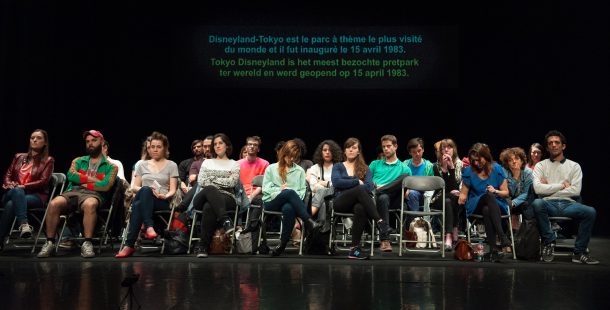
El Conde de Torrefiel’s GUERRILLA, written by Pablo Gisbert, directed by Pablo Gisbert and Tanya Beyeler. Photo: Titanne Bregentzer.
GUERRILLA by the Spanish group El Conde de Torrefiel, written by Pablo Gisbert and directed by Pablo Gisbert and Tanya Beyeler, was presented at the Beursschouwburg. Like many of the productions in the 2016 festival, it challenges a number of theatrical conventions. None of the actors speak; a narrative text appears on the screen above the stage, with a few short dialogues in Flemish and in French. There are no individualized characters on the stage, only in the written dialogues that the spectators read; there is no single dramatic plot, but many anecdotes. Three different sets are presented, while the text evokes many other places not shown; the relation between the written text and what happens on stage implies a very unusual temporal development.
The text—as do many of Gisbert’s texts—narrates episodes portraying an uneasiness at the transformation of the world and its values, mixed with many diverse philosophical, political or sociological reflections. The performance is divided into three sections created by the three spaces and by the activities that take place in them: a lecture, presumably by Romeo Castellucci, about a hypothetical future World War, a Tai Chi session, and a rave. The entire cast is shown attending each event in sequence and themes from them overlap. The production ends with the rave and shows perhaps one hundred performers dancing, backs to the audience. Text continues to appear on the screen, combining anecdotes and political remarks, about the confusing and contradictory world that the different characters live in and stressing the contrast between our hyperactivity and our passivity in the face of the world. The grim message of the text, however, contrasts with the festive atmosphere of the party. The music grows louder until it reaches a point where the earplugs that each spectator found on his seat when he came into the theatre become necessary.

Milo Rau’s 5 Easy Pieces. Photo: Phile Deprez.
The production Five Easy Pieces by Milo Rau also challenges the limits of the theatre, especially in its representation of violence. Rau is a Belgian director and filmmaker whose work has won many awards at the most prestigious theatre festivals. If the performance of children in children’s theatre is unusual, their presence in productions intended for adults tends to be more limited still. Yet Milo Rau’s production, created for an adult audience, uses children as the main actors, their presence justified both from a dramaturgical and theatrical point of view. They perform the story of Marc Dutroux, the Belgian murderer, arrested by the police in 1996, who raped and murdered six girls and whose arrest and trial produced a moral crisis in Belgian society. An adult, playing a theatre director, and seven children, between eight and thirteen years old—Rachel Dedain, Maurice Leerman, Pepijn Loobuyk, Willem Loobuyck, Polly Persyn, Peter Seynaeve, Elle Liza Tayou, and Winne Vanacker—presented this horrific story. An uncomfortable feeling is generated among the audience from the outset, both because of the story and due to the ambiguous and seemingly unhealthy attitude of the “director” towards the children.
The director begins by asking each of the children to stand up and answer questions about themselves. A close-up of his face is projected on the screen behind him. The tone of the questions is harsh, and he grimaces with scorn and disdain at the answers, creating an ambiguity about his character: he seems to evoke the sadistic murderer more than a balanced person. After questions about their identity he asks them about acting. One little girl sings John Lennon’s “Imagine” in her childish voice, while another plays piano, before being sharply interrupted by the director. Sometimes the questions seem close to perversion: he asks them to think about death, or to imagine that they are adults and that one of their children die; he shows them a photo of Marc Dutroux and asks them if they know this man; he also points out the cruelty of the children when he asks them if they had ever killed animals and if they liked it
Marc Dutroux’s story itself is divided into five parts, each presented by the children. The first part shows the background of the murderer, beginning with his childhood in the Congo. Dutroux’ family, the king of Belgium and Lumumba, the leader of the Congo’s decolonization, are all presented on stage in a manner that would be repeated in the following parts. On the screen above the stage, adult actors—Sara De Bosschere, Pieter-Jan De Wyngaert, Johan Leysen, Peter Seynaeve, Jan Steen, Ans Van den Eede, Hendrik Van Doorn, and Annabelle Van Nieuwenhuyse—play the characters and the spectators hear their voices. Onstage, the children are dressed in the same way and repeat the gestures made by the adults. Soon the children’s voices replace those of the adults, whose images gradually disappear from the screen. A child, made up as an old man, begins to play Victor Dutroux, Marc’s father. His face appears in close-up on the screen, saying that he doesn’t understand what his son did. Adults played by children remind the audience that the victims were children and that the murderer was first a child, but also that the image of innocence in children that we have is not always accurate.
The second part shows the complexity of the case, with the same theatrical device: a child, dressed as a policeman, explains how difficult it was to resolve the case. The third part was perhaps the most moving and shocking: the director asks a little girl to sit in a bed and to take off her shirt. At first she refuses to do it, but finally, she complies. Half naked, her figure is projected on the screen, as she reads a letter written by one of the little girls that was kidnapped and later killed by Marc Dutroux, explaining her everyday life The fourth part shows the kidnapping from the view of the parents, their long and unfruitful search in trying to find their child, and their pain and frustration and their sorrow and grief when they had to identify the children’s corpses. The fifth part portrays the mourning and the anger provoked by the crimes, all still presented by the child actors, a profoundly moving and disturbing presentation.
Zvizdal, a production by the group BERLIN (Bart Baele, Yves Degryse and Cathy Blisson) presented at BRONKS in Brussels, was a performance based on a film. The theatre is divided in two parts by a screen; the audience sits on both sides. Under the screen, there are three models of the same farm during different seasons of the year. A rail fixed to the bottom of the screen, carrying a camera, moves from one model to the other and its images are interpolated within the film. In the model, little figures represent animals and people. The film shows the life of two very old people, Nadia and Petro, who were the only people who remained not only in their village, Zvizdal, but also in the entire region surrounding the nuclear station of Chernobyl, in the Ukraine. The region had been converted since the explosion in 1986 into an exclusion zone, in which it is forbidden to live due to the radioactivity. When others left, and when the government offered the elderly couple an apartment in a city, they still refused to leave and remained at the farm with a few animals, lacking all services (running water, electricity, etc.).
The film is strange and moving for several reasons. At the beginning, there is nothing on the screen as a narrator explains how difficult it was to enter the exclusion zone, and how the film crew did not succeed at first in obtaining a permit to enter from the government. The region of Chernobyl seems to be an empty space as well as an empty time. The shooting lasted for four years, during which time the film crew paid a number of visits to this couple, mainly during the summers due to the fact that the roads were closed by snow during the winter. The film gives the impression of time passing slowly, fixed by the change of the seasons: the shots are very long—in fact, many images do not show any action. In most of the scenes, the couple is silent, just waiting for an action to happen. The time provokes a pure sensation of waiting and of duration.
One by one the farm animals die. Tired, the man begins to say that his life too is over. The audience becomes witness to a real, announced death. The following images of the film show the man’s funeral. The woman, left alone, still refuses to leave her farm. One of the guards of the exclusion zone says that if the old woman stays alone during the winter there is little chance that she will survive. One month later, when the film crew once again pays a visit to the old woman, she appears very disoriented, taking longer to answer, walking with difficulty. An aerial view of the farm shows how nature has begun to grow around her area just like the other abandoned farms of the neighborhood. The woman announces that she wouldn’t be there after the winter, and gives her best wishes to the people with whom she is speaking, directly into the camera. This is the final image, and the public left the theatre with sadness.
chelfitsch’s production of Toshiki Akada’s Time’s Journey Through a Room presented another original use of the theme of time. Although its story is banal and predictable, the precision of the rhythm, the simplicity of the scenery and the precision of the acting made this a beautiful and brilliant production. Japanese playwright and director Toshiki Akada has been directing his own plays with his company chelfitsch since 1997. The scenery here was very simple: a white thin backdrop, that the wind sometimes lifted during the performance; on stage right a small table, with a vase and two pink carnations, and a chair; in the background another chair turned upstage; stage right, a suspended lamp; further upstage, a black vase with white tissue that could turn like a weathervane and a blue cube from which light emanated, and almost at the level of the backdrop, a metallic disk that reflected the light.
Three actors (Izumi Aoyagi, Mari Ando, Yo Yoshida) perform the story, whose main topic is the passing of time and the difficulty of separation and loss. In the opening scene, an actress enters, looking at the audience for a long time before telling them that the production is about to begin, and asking them to close their eyes until she says to open them again. When the audience opens their eyes, the woman has disappeared, and a man is sitting on the chair, looking upstage. Another woman enters and begins to speak, taking long pauses, with a very soft voice in an almost joyful tune, about the events of everyday life. She tells him about a tsunami that changed their lives, providing them with a new beginning. Without the spectators knowing why, the man doesn’t answer her, wringing his hands instead, tormented. This scene is interrupted a few times by the first woman, who now becomes a character, coming downstage on the right to announce that she has an appointment with a man who invited her to his house, and that she thinks that a relationship will begin.
Whilst the first woman waits in front of what was supposed to be the man’s apartment, the two stories are combined. The three actors, with somber, distant acting, present a painful text while avoiding all pathos. The man explains that his wife died suddenly two years ago, four days after the tsunami, and that he wants to establish a new relation with another woman, because he cannot continue to live with the memories of his wife. The resignation more than the desire seem to be his motivation. The audience comes to understand that the dead wife is the character who was speaking to him, whom he is unable to forget: he is haunted by the memory of his wife. Mysteriously, she is happier than she has ever been. She is still there listening to her husband speak to the desired new partner, who accepts the man’s proposition calmly. The dead wife remains there, between the man and his new partner, until she finally reveals that her husband never really loved her and she asks him to truly love his new partner. When she exits the stage, leaving the new couple motionless, the light flickers, diminishes and brightens again two times as if the story were not finished or could hardly finish there.
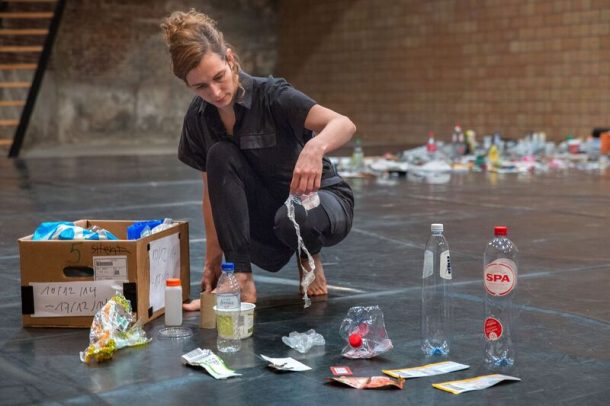
Sarah Vanhee’s Oblivion. Photo: Phile Deprez.
Oblivion by Belgian performer Sarah Vanhee was another daring production in the festival, based on a radical ecological and philosophical idea. When the audience enters the theatre, Vanhee is already on stage, taking waste material out of a box and putting it on the stage. Over the course of one year, as she explains during the production, she has collected all the inorganic waste she has produced into boxes. Forty-two big cardboard boxes, individually dated in groups of five and ten days, are positioned close to the left stage wall. When the performer empties one of them, she brings it to the right stage wall. She sets every piece of waste on stage, slightly separated from one another: plastic water bottles, wine bottles, bottles of beer, yogurt cups, tins, milk cartons, boxes of chocolate, plastic and paper bags, a variety of lids, cardboard boxes, wrappers, packing material, some clothes, many types of paper—individual sheets, newspapers—and so on. Soon after the beginning of the performance, she begins to speak in a monotonous monotone, accumulating repetitive sentences and enumerations of objects, as she places the waste on the stage, separating everything but without apparent preference. Even more: her pitch seems to erase all hierarchy among the information transmitted, creating a parallel with the manner in which she places the rubbish on stage. She speaks at length about waste, organic, physical, or inorganic, suggesting to the spectator that he is not very conscious of how much waste he produces. At the beginning, the performer seems to be creating something on stage, occupying certain parts, but very quickly the audience understands that the waste will take up the entire stage, around twenty meters by twenty meters. With this action Vanhee provokes a reflection on how we consume, how we deal with objects once used, and how throwing them away has become an unconscious habit. In two hours and twenty minutes without intermission, the performer empties all the boxes, demonstrating a single physical action: the result, pedagogical and demonstrative, is impressive, showing the public how much waste we accumulate in one year, displaying a striking image with all the stage covered in waste.
Web of Trust by Edit Kaldor is an experiment in how new relationships are created, and perhaps in new forms of socialization. Edit Kaldor, a Hungarian who now lives in Amsterdam, uses a variety of media in his productions. At the beginning of Web of Trust there are two people on stage, with their laptops: they are communicating via the internet with a group of people from different backgrounds. Their messages and their answers, as well as their faces, are shown on a screen that serves as a backdrop. The communication takes place in English, French, and German among a varying number of people from different parts of the world. Some of the participants attempt to write down the rules of their group, but they all write at the same time, correcting each other, erasing what others write. All have different needs. Some are personal (a man who has a disease that forces him into isolation except for the internet); some are political (a group of undocumented workers who want to speak about their situation). Others just want to express personal desires, like the African refugee who lives in Berlin and wants to find a translator in order to translate a book he has written.
From the audience’s point of view, the performance is slow with many empty moments, putting them in a passive position, watching something not very different from what they were used to in everyday life. After about forty-five minutes, one of the women on stage says that this production was about what the public had seen until this point, and that if some spectator wanted, they could come on stage and use the computer, “feel free to have a beer, to speak with the others,” but by then most of the audience had left the theatre.
The production of Germain Kruip’s A Possibility of an Abstraction, presented at the Kaaitheater, was for many reasons both astonishing and risky. Light was projected onto a completely empty stage, and electronic music was heard. Then came a succession of lights that created abstract images and evoked abstract paintings, all without actors, props, scenery, text or words. Could it be interpreted as abstract theatre, as the title suggests? I don’t even know if this could be called theatre, despite the fact that it happened in a theatre.
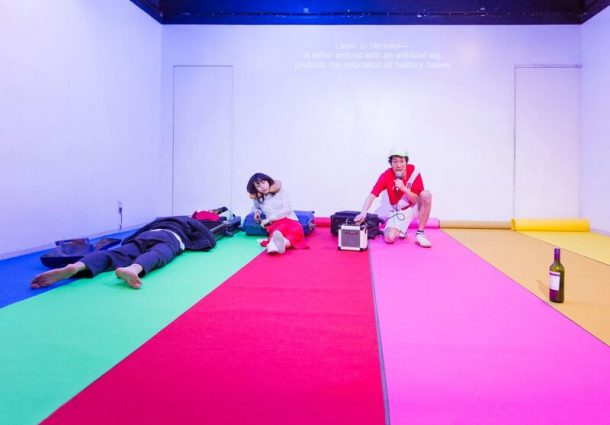
Okazaki Art Theatre’s 51 Aviación, San Borja, directed by Yudai Kamisato. Photo: Yuta Fukitsuka.
The Okazaki Art Theatre from Japan, directed by Yudai Kamisato, presented 51 Aviación, San Borja at Les Brigittines The production represents a journey by Kamisato, of Peruvian-Japanese background, from Tokyo to Okinawa, and offers an insight into immigration experiences, and the difficulty of achieving understanding between people of different origins. A simple white screen was used as a backdrop and a carpet with brightly colored stripes covered the empty stage. The actors enter the stage smiling and telling separate narratives with no dialogue. While speaking, they open suitcases and scatter the contents on the stage. With mechanical and parodic gestures, the three actors narrate trips taken by the protagonist, as well as those of other people he met while traveling, creating many levels of reporting. They speak in particular about the surprise of people of Japanese origin, born in South America, who come to Japan to be stunned by the deafening noises of the cities, the visual sensations, and so on. Themes of nostalgia, displacement and identity constantly recur, creating a kind of collage of displacement.
Amir Reza Koohestani, an Iranian author and director of the Mehr Theatre Group, presented Hearing at the Palais des Beaux-Arts, a production that concerned the present cultural and political situation in Iran. It denounced the repression of freedom, the hypocrisy in habits and attitudes toward sex and its consequences for people’s lives, the denunciations, the shame, and the feelings of guilt. As a metaphor for this overall situation, the director staged a minor episode that shows the disproportionate measures taken to discover the truth and the gravity of the consequences in the characters’ lives. The story takes place in the dormitory of a girls’ school, following a night in which one girl invited her boyfriend to stay. The fact is known by the authorities because somebody made an anonymous report. An inquiry is undertaken, and all the girls of the dormitory, fearing the consequences, denounce the guilty one, who is expelled from the dormitory. She emigrates and later commits suicide. Fifteen years later one of the testifying girls, possibly the accuser, is shown, still suffering guilt over the incident. The production was performed by Mona Ahmadi, Ainaz Azarhoush, Elham Korda, and Mahin Sadri.
From Syria came a production by Omar Abusaada, While I Was Waiting, written by Mohammad Al Attar, presented at the Théâtre la Balsamine. The production provided a Syrian point of view about this ongoing conflict so frequently presented by the Western media from its own perspective. Six actors (Amal Omran, Mohammad Alarashi, Nanda Mohammad, Fatina Laila, Mouiad Roumieh, and Mohamad Al Refai) denounce the current Syrian situation, the war, the violence, and its consequences for the life of the people, through the story of a man Taym, who is in a coma, as result of the tortures he suffered at a checkpoint in Damascus. Taym’s relatives who have refused to leave Damascus during the war—his mother, his sister, his fiancé Salma, and one of his friends—visit him at the hospital. Their dialogues, often passionate, reveal the relationships and the story of this middle class family that, once quite conventional, has been completely transformed by the war. At the same time, two other actors play the protagonist and the director. Taym, the main character, is lying motionless on the bed at the opening of the performance, but during the first scene he climbs onto the second floor of the set, where he performs the flashbacks.
Director Abusaada is also present on stage. He observes the other characters from the second floor that he never leaves, or he works on what looks like a music mixer, in which he seems to deal with the soundtrack of the production. Occasionally he speaks directly as an author, with anecdotes in which he denounces the violence of all the factions that are fighting. He explains his own experience in the war, and the way he switched his opinion, finally coming to think that the rebellion acts as the power: at first he admired the Al’Nushra Front, but finally rejected Daesch when a man he knew—also rebelling against the power, but belonging to a different faction—was tortured. The action takes place in 2015, but the events related begin in 2011.
Family scenes are mixed with flashbacks, in which the protagonist decides to make a film about the political situation. Images of the real first riots are projected, where the enthusiasm of the people who participate in them is visible, a technique reminiscent of documentary theatre. These show how the first pacifist protests become progressively more radical and finally erupt into war. The protagonist narrates his experience in prison, and how he saw tortured prisoners dying, but also how he resolved to continue to film the war, instead of leaving the country. In the end, the situation remains open and desperate. No exit is proposed, no change can be imagined. The suffering continues.
Manuel García Martinez is Senior Lecturer in French Literature at the University of Santiago de Compostela. He wrote his Ph.D. in Drama Studies at University Paris 8. His research interests are time and rhythm in theatrical productions/performances and in dramatic texts, the French contemporary theatre, and the Canadian theatre.
European Stages, vol. 8, no. 1 (Fall 2016)
Editorial Board:
Marvin Carlson, Senior Editor, Founder
Krystyna Illakowicz, Co-Editor
Dominika Laster, Co-Editor
Kalina Stefanova, Co-Editor
Editorial Staff:
Cory Tamler, Managing Editor
Mayurakshi Sen, Editorial Assistant
Advisory Board:
Joshua Abrams
Christopher Balme
Maria Delgado
Allen Kuharsky
Bryce Lease
Jennifer Parker-Starbuck
Magda Romańska
Laurence Senelick
Daniele Vianello
Phyllis Zatlin
Table of Contents:
- The 70th Avignon Festival: An Experiment In Living Together by Philippa Wehle
- The 2016 Berlin Theatertreffen: Is Half a Festival Better Than None? by Marvin Carlson
- Introduction au Kunstenfestivaldesarts de Bruxelles 2016 by Manuel García Martínez
- The Fidena Festival, 2016 by Roy Kift
- The Noorderzon Festival in Groningen by Manuel García Martínez
- Review of The Suicide by Steve Earnest
- Spain: Runaway Hits and Ephemeral Memorabilia by Maria M. Delgado
- The Seagull: An Idea for a Short Story by Emiliia Dementsova
- Billy Elliot The Musical at the Hungarian State Opera by James Wilson
- Chorus of Orphans: A Theatre Séance by Poland’s Teatr KTO, Kraków by Jacob Juntunen
- Theatre More Arresting than Ever: A Conversation with Dorota Masłowska by Krystyna Lipinska Illakowicz
Martin E. Segal Theatre Center:
Frank Hentschker, Executive Director
Marvin Carlson, Director of Publications
Rebecca Sheahan, Managing Director
©2016 by Martin E. Segal Theatre Center
The Graduate Center CUNY Graduate Center
365 Fifth Avenue
New York NY 10016
